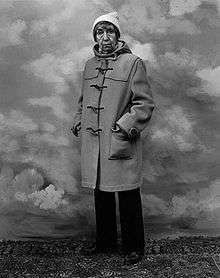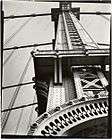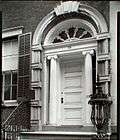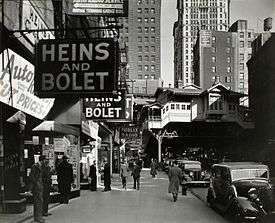Berenice Abbott
| Berenice Abbott | |
|---|---|
 Berenice Abbott by Hank O'Neal in New York City, November 18, 1979 | |
| Born |
Bernice Abbott July 17, 1898 Springfield, Ohio, US |
| Died |
December 9, 1991 (aged 93) Monson, Maine, US |
| Nationality | United States |
| Known for | Photography |
Berenice Abbott (July 17, 1898 – December 9, 1991),[1] née Bernice Abbott, was an American photographer best known for her black-and-white, scientific photography of New York City architecture and urban design of the 1930s.
Early years
Abbott was born in Springfield, Ohio[2] and brought up there by her divorced mother. She attended the Ohio State University, but left in early 1918.[3]
in theater and sculpture.[4] In 1919 she nearly died in the influenza pandemic.[5]
Trip to Europe, photography, and poetry
weed , spending two years studying sculpture in Paris and Berlin.[1] She studied at the Académie de la Grande Chaumiere in Paris and the Prussian Academy of Arts in Berlin.[6] During this time, she adopted the French spelling of her first name, "Berenice," at the suggestion of Djuna Barnes.[7] In addition to her work in the visual arts, Abbott published poetry in the experimental literary journal transition.[8] Abbott first became involved with photography in 1923, when Man Ray hired her as a darkroom assistant at his portrait studio in Montparnasse. Later she wrote: "I took to photography like a duck to water. I never wanted to do anything else." Ray was impressed by her darkroom work and allowed her to use his studio to take her own photographs.[9] In 1926, she exhibited her work in the gallery "Au Sacre du Printemps" and started her own studio on the rue du Bac. After a short time studying photography in Berlin, she returned to Paris in 1927 and started a second studio, on the rue Servandoni.[10]
Abbott's subjects were people in the artistic and literary worlds, including French nationals (Jean Cocteau), expatriates (James Joyce), and others just passing through the city. According to Sylvia Beach, "To be 'done' by Man Ray or Berenice Abbott meant you rated as somebody".[11] Abbott's work was exhibited with that of Man Ray, André Kertész, and others in Paris, in the "Salon de l'Escalier" (more formally, the Premier Salon Indépendant de la Photographie), and on the staircase of the Théâtre des Champs-Élysées. Her portraiture was unusual within exhibitions of modernist photography held in 1928–9 in Brussels and Germany.[12]
In 1925, Man Ray introduced her to Eugène Atget's photographs. She became interested in Atget's work,[13] and managed to persuade him to sit for a portrait in 1927. He died shortly thereafter. While the government acquired much of Atget's archive — Atget had sold 2,621 negatives in 1920, and his friend and executor André Calmettes sold 2,000 more immediately after his death[14] — Abbott was able to buy the remainder in June 1928, and quickly started work on its promotion. An early tangible result was the 1930 book Atget, photographe de Paris, in which she is described as photo editor. Abbott's work on Atget's behalf would continue until her sale of the archive to the Museum of Modern Art in 1968. In addition to her book The World of Atget (1964), she provided the photographs for A Vision of Paris (1963), published a portfolio, Twenty Photographs, and wrote essays.[15] Her sustained efforts helped Atget gain international recognition.
Changing New York


In early 1929, Abbott visited New York City, ostensibly to find an American publisher for Atget's photographs. Upon seeing the city again, however, Abbott immediately saw its photographic potential. Accordingly, she went back to Paris, closed up her studio, and returned to New York in September. Her first photographs of the city were taken with a hand-held Kurt-Bentzin camera, but soon she acquired a Century Universal camera which produced 8 x 10 inch negatives.[16] Using this large format camera, Abbott photographed New York City with the diligence and attention to detail she had so admired in Eugène Atget.[17] Her work has provided a historical chronicle of many now-destroyed buildings and neighborhoods of Manhattan.
Abbott worked on her New York project independently for six years, unable to get financial support from organizations (such as the Museum of the City of New York), foundations (such as the Guggenheim Foundation), or individuals. She supported herself with commercial work and teaching at the New School of Social Research beginning in 1933.[18] In 1935, however, Abbott was hired by the Federal Art Project (FAP)[1] as a project supervisor for her "Changing New York" project. She continued to take the photographs of the city, but she had assistants to help her both in the field and in the office. This arrangement allowed Abbott to devote all her time to producing, printing, and exhibiting her photographs. By the time she resigned from the FAP in 1939, she had produced 305 photographs that were then deposited at the Museum of the City of New York.[16] Abbott's project was primarily a sociological study embedded within modernist aesthetic practices. She sought to create a broadly inclusive collection of photographs that together suggest a vital interaction between three aspects of urban life: the diverse people of the city; the places they live, work and play; and their daily activities. It was intended to empower people by making them realize that their environment was a consequence of their collective behavior (and vice versa). Moreover, she avoided the merely pretty in favor of what she described as "fantastic" contrasts between the old and the new, and chose her camera angles and lenses to create compositions that either stabilized a subject (if she approved of it), or destabilized it (if she scorned it).[19]
Abbott's ideas about New York were highly influenced by Lewis Mumford's historical writings from the early 1930s, which divided American history into a series of technological eras. Abbott, like Mumford, was particularly critical of America's "paleotechnic era," which, as he described it, emerged at end of the American Civil War, a development called by other historians the Second Industrial Revolution. Like Mumford, Abbott was hopeful that, through urban planning efforts (aided by her photographs), Americans would be able to wrest control of their cities from paleotechnic forces, and bring about what Mumford described as a more humane and human-scaled, "neotechnic era". Abbott's agreement with Mumford can be seen especially in the ways that she photographed buildings that had been constructed in the paleotechnic era—before the advent of urban planning. Most often, buildings from this era appear in Abbott's photographs in compositions that made them look downright menacing.[19]
In 1935, Abbott moved into a Greenwich Village loft with the art critic Elizabeth McCausland, with whom she lived until McCausland's death in 1965. McCausland was an ardent supporter of Abbott, writing several articles for the Springfield Daily Republican, as well as for Trend and New Masses (the latter under the pseudonym Elizabeth Noble). In addition, McCausland contributed the captions for the book of Abbott's photographs entitled Changing New York which was published in 1939. In 1949, her photography book Greenwich Village Today and Yesterday was published by Harper & Brothers.
Gallery
| Wikimedia Commons has media related to Changing New York. |
-

Pike Street at Henry Street (1936)
-

Automat in Manhattan (1936)
-

Pennsylvania Station (1936)
-

Detail of Manhattan Bridge (1936)
-
.jpg)
Wanamaker's department store, Fourth Avenue and Ninth Street (1936)
-

Financial District rooftops (1938)
-

Seventh Avenue, looking south from 35th Street (1935)
-

Flatiron Building (1938)
-

House doorway on East 4th Street, Manhattan (1937)
-

Hot dog stand, North Moore Street, Manhattan (1936)
-

Hardware store on the Bowery in Manhattan (1938)
-

Radio Row at Cortlandt Street (1936)
Beyond New York City
In 1934 Henry-Russell Hitchcock asked Abbott to photograph two subjects: antebellum architecture and the architecture of H. H. Richardson.
Two decades later, Abbott and McCausland traveled US 1 from Florida to Maine, and Abbott photographed the small towns and growing automobile-related architecture.[1] The project resulted in more than 2,500 negatives. Shortly after, Abbott underwent a lung operation. She was told she should move from New York City due to air pollution and she bought a rundown home in Blanchard, Maine along the banks of the Piscataquis River for US$1,000. Later she moved to nearby Monson, remaining in Maine until her death in 1991.
Abbott's work in Maine continued after that project and after her move to Maine and her last book was A Portrait of Maine (1968).
Approach to photography
Abbott was part of the straight photography movement, which stressed the importance of photographs being unmanipulated in both subject matter and developing processes. She also disliked the work of pictorialists who had gained much popularity during a substantial span of her own career, and therefore left her work without support from this particular school of photographers.
Throughout her career, Abbott's photography was very much a display of the rise in development in technology and society. Her works documented and praised the New York landscape. This was all guided by her belief that a modern-day invention such as the camera deserved to document the 20th century.[20]
Scientific work
Abbott was not only a photographer, but also the founder of the "House of Photography", created in 1947 to promote and sell some of her inventions. These included a distortion easel, which created unusual effects on images developed in a darkroom, and the telescopic lighting pole, known today by many studio photographers as an "autopole," to which lights can be attached at any level. Owing to poor marketing, the House of Photography quickly lost money, and with the deaths of two designers, the company closed.
Abbott's style of straight photography helped her make important contributions to scientific photography. In 1958, she produced a series of photographs for a high-school physics textbook, developed by the Physical Science Study Committee project based at MIT to improve secondary school physics teaching. Her work included images of wave patterns in water and stroboscopic images of moving objects, such as Bouncing ball in diminishing arcs, which was featured on the cover of the textbook.[21] In 2012, some of her work from this era would be displayed at the MIT Museum in Cambridge, Massachusetts.[22]
Personal life
The film "Berenice Abbott: A View of the 20th Century", which showed 200 of her black and white photographs, suggests that she was a “proud proto-feminist”; someone who was ahead of her time in feminist theory. Before the film was completed she questioned, "The world doesn't like independent women, why, I don't know, but I don't care." She lived with art critic Elizabeth McCausland for 30 years and is in major lesbian artist archives.[23]
Work
Notable photographs
- Under the El at the Battery, New York, 1936.
- Nightview, New York, 1932.
- James Joyce, 1928.
Solo Exhibitions
- Solo exhibition at Weyhe Gallery, New York, NY, November 1930[24]
- Photographs by Berenice Abbott at Julien Levy Gallery, New York, NY, September 26 – October 15, 1932
- New York Photographs by Berenice Abbott at Museum of the City of New York, New York, NY, October 1934 – January 1935
- New York Photographs by Berenice Abbott at Museum of Fine Arts, Springfield, MA, March 1935
- New York Photographs by Berenice Abbott at Jerome Stavola Gallery, Hartford, CT, April 1935
- New York Photographs by Berenice Abbott at Fine Arts Guild, Cambridge, MA, April 10–15, 1935
- Changing New York, Washington Circuit, Federal Art Project, traveling exhibition, 1936
- Changing New York at Museum of the City of New York, New York, NY, October 20, 1937 – January 3, 1938
- Changing New York at Teachers College Library, New York, NY, November 1937
- Solo exhibition at Hudson D. Walker Gallery, New York, NY, April 1938
- Changing New York at New York State Museum, Albany, NY, July 1938
- Changing New York at Federal Art Gallery, New York, NY, April 11–22, 1939
- Solo exhibition at Architectural League, New York, NY, April 1939
- Changing New York at Lawrenceville School, Lawrence Township, NJ, May 1939
- Changing New York at Photo League Gallery, New York, NY, July 1939
- Changing New York at New York State Employment Service, New York, NY, November–December 1939
- Changing New York at Walton High School, New York, NY, December 1939
- Photographs of New York by Berenice Abbott at The Cooper Union Library, New York, NY, November 25 – December 9, 1940
- Berenice Abbott, The Museum of Modern Art, New York, NY, December 10, 1970–February 28, 1971
- Berenice Abbott: The Red River Photographs at Hudson D. Walker Gallery, Provincetown, Massachusetts, August 24 – September 6, 1979.[25]
- Documenting New York: Photographs by Berenice Abbott, Dallas Museum of Art, Dallas, Texas,1992
- Berenice Abbott: Portraits, New York Views, and Science Photographs from the Permanent Collection, International Center for Photography, New York, NY, 1996
- Berenice Abbott’s Changing New York, National Museum of Women in the Arts, Washington D.C.,1935-1939, 1998–99
- Berenice Abbott: All About Abbott, Howard Greenberg Gallery, New York, NY, September 15 - November 4, 2006
- Making Science Visible: The Photography of Berenice Abbott, The Fralin Museum of Art, Virginia, 2012
- Berenice Abbott (1898-1991), Photographs, Jeu de Paume, Paris, France, February 21 - April 29, 2012
- Berenice Abbott: Photography and Science: An Essential Unity, MIT Museum, Cambridge, Massachusetts, May 3 - December 31, 2012
- Berenice Abbott, Beetles & Huxley Gallery, London, England, October 27 – November 21, 2015
- Berenice Abbott – Photographs, Martin-Gropius-Bau, Berlin, Germany, January 7 – March 10, 2016
Group Exhibitions
- Photographs of New York by New York Photographers (group) at Julien Levy Gallery, New York, NY, May 2 – June 2, 1932
- A History of Women Photographers, National Museum of Women in the Arts, Washington D.C.,1997
- Defining Eye: Women Photographers of the 20th Century, National Museum of Women in the Arts, Washington D.C.,1999–2000
- From the Collection: Portraits of Women by Women, National Museum of Women in the Arts, Washington D.C., 2006
- A World of Its Own: Photographic Practices in the Studio, The Museum of Modern Art, New York, NY, February 8–November 2, 2014
- Modern Photographs from the Thomas Walther Collection, 1909–1949, The Museum of Modern Art, New York, NY, December 13, 2014–April 19, 2015
- Revelations: Experiments in Photography, Science Museum, London, England, November 20, 2015 – February 3, 2016
Bibliography
Books of photographs by Berenice Abbott:
- Changing New York. New York: Dutton, 1939. With text by Elizabeth McCausland.[1]
- Reprint: New York in the Thirties, as Photographed by Berenice Abbott (New York: Dover, 1973).[1]
- Greatly augmented, annotated edition: Bonnie Yochelson, ed., Berenice Abbott: Changing New York (New York: New Press and the Museum of the City of New York, 1997; ISBN 1-56584-377-0).
- Greenwich Village: Yesterday and Today. New York: Harper, 1949. With text by Henry Wysham Lanier.
- A Portrait of Maine. New York: Macmillan, 1968. With text by Chenoweth Hall.
Other books by, or with major contributions from, Berenice Abbott:
- Atget, photographe de Paris. Paris: Henri Jonquières; New York: E. Weyhe, 1930. (As photograph editor.)
- The Attractive Universe: Gravity and the Shape of Space. Cleveland: World, 1969. With text by Evans G. Valens.
- A Guide to Better Photography. New York: Crown, 1941. Revised edition: New Guide to Better Photography (New York: Crown, 1953).
- Magnet. Cleveland: World, 1984. With text by Evans G. Valens.
- Motion. London: Longman Young, 1965. With text by Evans G. Valens.
- Twenty Photographs by Eugène Atget 1856–1927.
- The View Camera Made Simple. Chicago: Ziff-Davis, 1948.
- A Vision of Paris: The Photographs of Eugène Atget, the Words of Marcel Proust. New York: Macmillan, 1963. Edited by Arthur D. Trottenberg.
- The World of Atget. New York: Horizon, 1964. (And later editions.)
- "Berenice Abbott." Germany/New York: Steidl, 2008. Berenice Abbott. Edited by Hank O'Neal and Ron Kurtz ISBN 3-86521-592-0
Anthologies of Abbott's works:
- Berenice Abbott. Aperture Masters of Photography. New York: Aperture, 1988.
- Berenice Abbott, fotografie / Berenice Abbott: Photographs. Venice: Ikona, 1986.
- Berenice Abbott: Photographs. New York: Horizon, 1970.
- Berenice Abbott: Photographs. Washington, D.C.: Smithsonian Institution Press, 1990.
- O'Neal, Hank. Berenice Abbott: American Photographer. New York: McGraw-Hill, 1982. British title: Berenice Abbott: Sixty Years of Photography. London: Thames & Hudson, 1982.
- Van Haaften, Julia, ed. Berenice Abbott, Photographer: A Modern Vision. New York: New York Public Library, 1989. ISBN 0-87104-420-X
References
- 1 2 3 4 5 6 "Abbott, Berenice". Encyclopedia Britannica. I: A-Ak – Bayes (15th ed.). Chicago, IL: Encyclopedia Britannica, Inc. 2010. pp. 12–13. ISBN 978-1-59339-837-8.
- ↑ "Abbott, Berenice". Who Was Who in America, with World Notables, v. 10: 1989–1993. New Providence, NJ: Marquis Who's Who. 1993. p. 1. ISBN 0837902207.
- ↑ Yochelson, pp. 9–10.
- ↑ Sculpture, Ray, Hartmann: Julia Van Haaften, "Portraits", Berenice Abbott, Photographer: A Modern Vision (New York: New York Public Library, 1989), p. 11.
- ↑ Yochelson, p. 10.
- ↑ Marter, Joan M. (2011). The Grove Encyclopedia of American Art, Volume I. Oxford University Press. pp. 9–10.
- ↑ Herring, Phillip (1995). Djuna: The Life and Work of Djuna Barnes. New York: Penguin Books. ISBN 0-14-017842-2.
- ↑ Benstock, Shari (1986). Women of the Left Bank: Paris, 1900–1940. Texas: University of Texas Press. ISBN 0-292-79040-6.
- ↑ Yochelson, p. 10. Abbott quotation: Abbott, untitled text dated December 1975, Berenice Abbott, Photographer: A Modern Vision, p. 8.
- ↑ Solo exhibition, studios: Van Haaften, "Portraits", Berenice Abbott, Photographer, p. 11.
- ↑ Beach quotation: Van Haaften, "Portraits", Berenice Abbott, Photographer, p. 11.
- ↑ Salon de l'Escalier, Belgian and German exhibitions: Van Haaften, "Portraits", Berenice Abbott, Photographer, p. 11.
- ↑ BERENICE ABBOTT (1898–1991). phillipscollection.org
- ↑ Harris, David (2000) Eugène Atget: Unknown Paris. New York: New Press. ISBN 1-56584-854-3. pp. 13, 15.
- ↑ Harris, David (2000) Eugène Atget: Unknown Paris. New York: New Press. ISBN 1-56584-854-3. pp. 8, 188.
- 1 2 Yochelson, introduction.
- ↑ jfFrank online
- ↑ O’Neal, Hank and Berenice Abbott. Berenice Abbott: American Photographer. Introduction by John Canaday. New York: McGraw Hill Book Company, 1982.
- 1 2 Barr, Peter (1997) Becoming Documentary: Berenice Abbott's Photographs 1925–1939. Ph.D. dissertation. Boston University.
- ↑ Yochelson, Berenice Abbott.
- ↑ Crisis in US Science Education? Better Call in Avant-Garde Photographer Berenice Abbott Forbes
- ↑ "MIT Museum: Exhibitions – Berenice Abbott: Photography and Science: An Essential Unity". Web.mit.edu. Retrieved June 15, 2013.
- ↑ newarkmuseum.wordpress.com/2012/06/22/berenice-abbott/
- ↑ This list of exhibitions comes from Meredith TeGrotenhuis Shimizu's dissertation, "Photography and Urban Discourse: Berenice Abbott's Changing New York and the 1930s," 2008
- ↑ Artforum, Summer 1979
Cited sources
- Bonnie Yochelson (1997). Berenice Abbott: Changing New York. New York: New Press. ISBN 1565845560.
Further reading
- Documentary Film: Berenice Abbott: A View of the Twentieth Century (1992)
- Stern, Keith (2009), "Abbott, Bernice", Queers in History, BenBella Books, Inc.; Dallas, Texas, ISBN 978-1-933771-87-8
- Noyes Platt, Susan (2004). "Berenice Abbott". In Susan Ware. Notable American Women: A biographical dictionary, completing the Twentieth Century. Cambridge, MA: Harvard University Press. pp. 2–3. ISBN 067401488X.
- Kauffman, Bette (1999). "Abbott, Berenice". In Commire, Anne. Women in World History: A biographical encyclopedia. 1. Waterford, CT: Yorkin Publications, Gale Group. pp. 11–17. ISBN 0787640808.
- Hillstrom, L. C., & Hillstrom, K. (1999). Contemporary women artists. Detroit: St. James Press.
- Butet-Roch, Laurence, "Berenice Abbott: Writing Her Own History," The New York Times, May 6, 2015
External links
- Berenice Abbott papers at Manuscripts and Archives Division at the New York Public Library (PDF)
- "Berenice Abbott: Changing New York" (New York Public Library)
- Abbott at New Mexico Museum of Art
- "Berenice Abbott photographs in the collections of the Museum of the City of New York"
- Berenice Abbott (International Photography Hall of Fame)
- Corinne, Tee A. "Berenice Abbott" (GLBTQ: An encyclopedia of gay, lesbian, transgender and queer culture.)
- Teicher, Jessica E. "Inspired by Berenice Abbott"
- "Berenice Abbott's Photographic Prints"(Commerce Graphics Ltd, Inc.)
- "Berenice Abbott" (The Jewish Museum (New York))
- Berenice Abbott (The Museum of Modern Art)
- Get the Picture: Berenice Abbott (Minneapolis Institute of Art)
- Berenice Abbott (Smithsonian Museum of Art)
- Berenice Abbott (The Phillips Collection)
- Berenice Abbott (Archives of Women Artists, Research and Exhbitions)